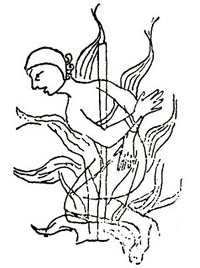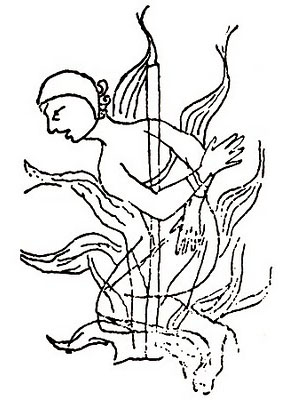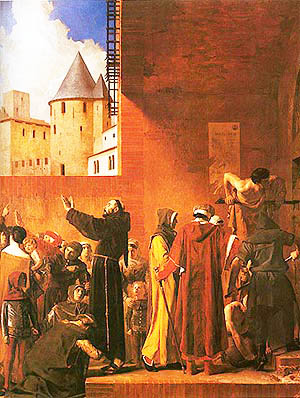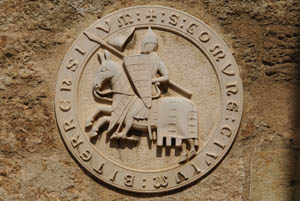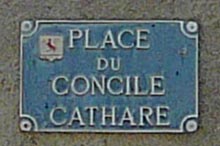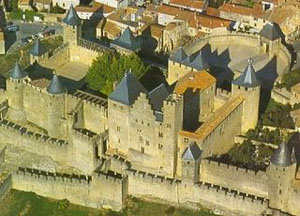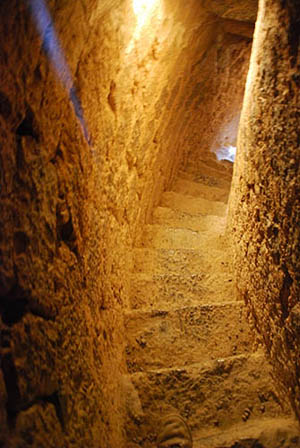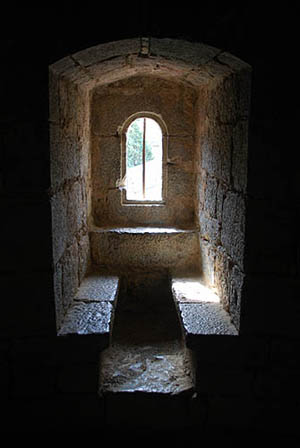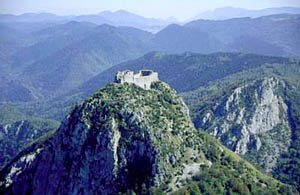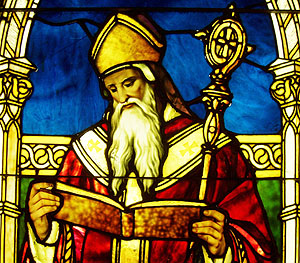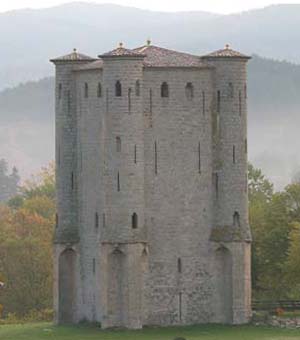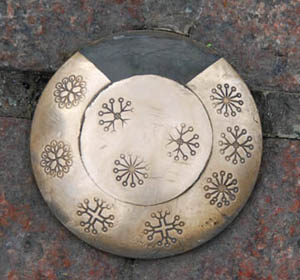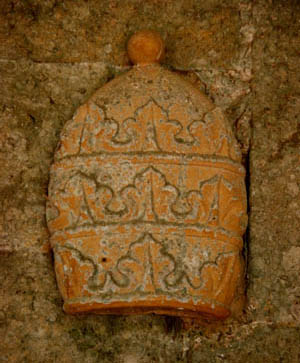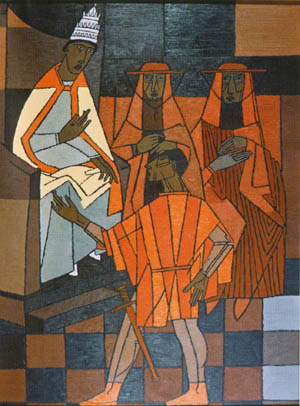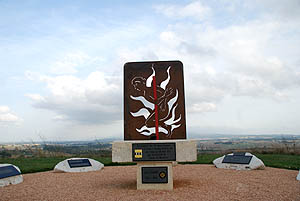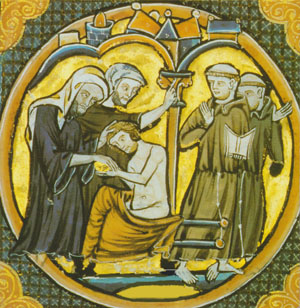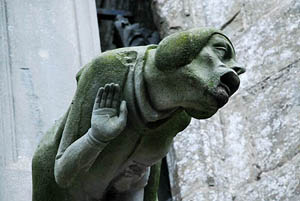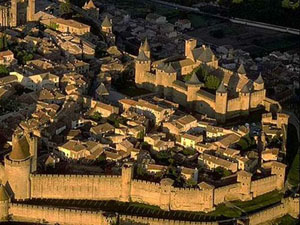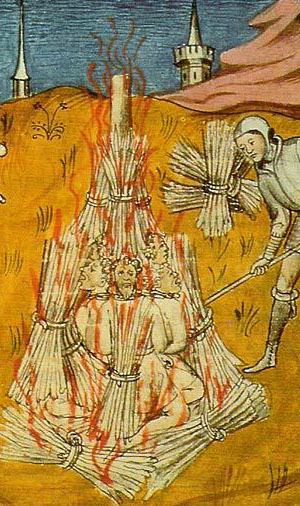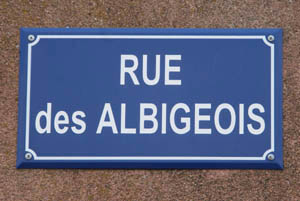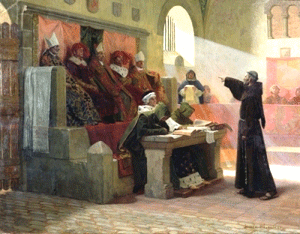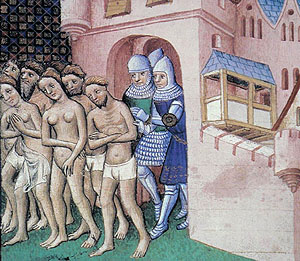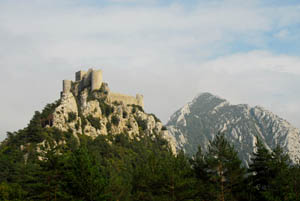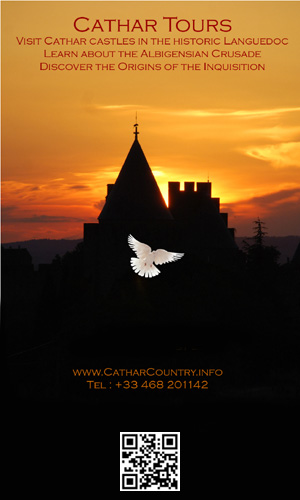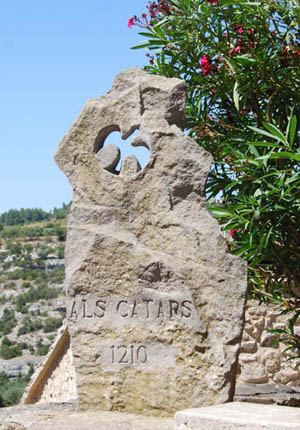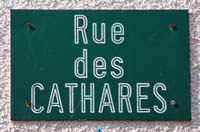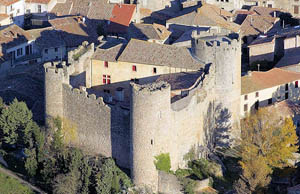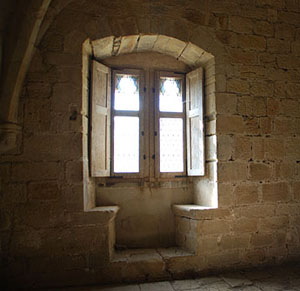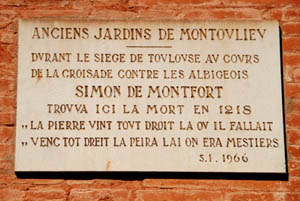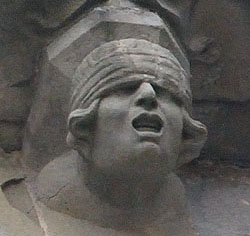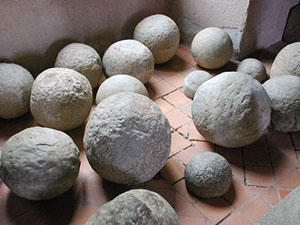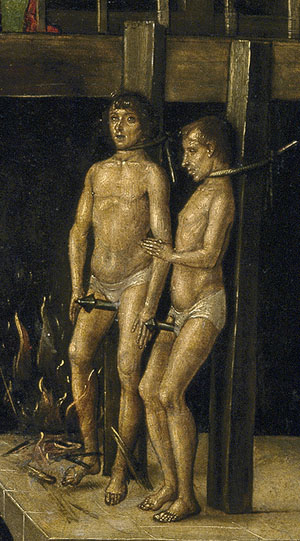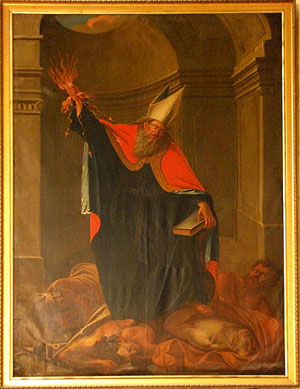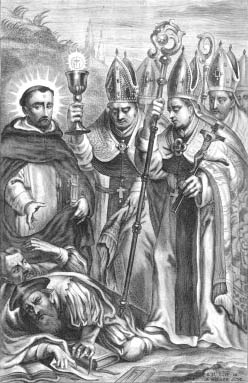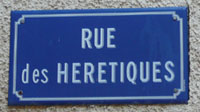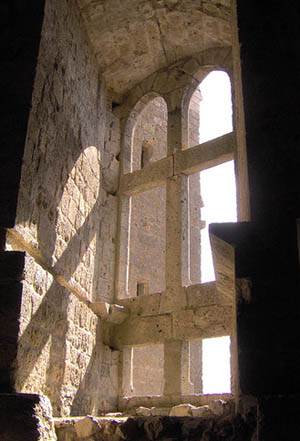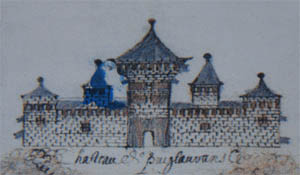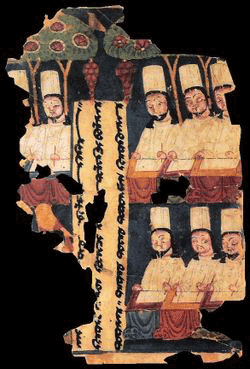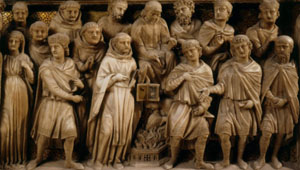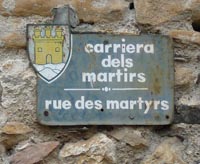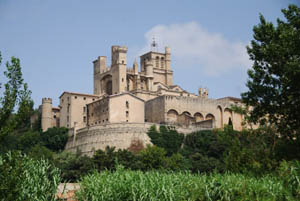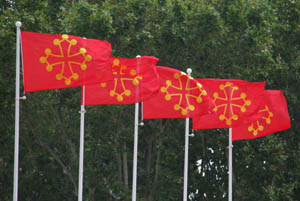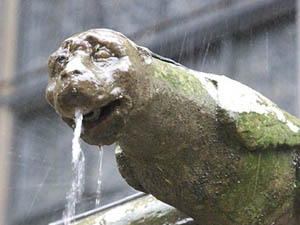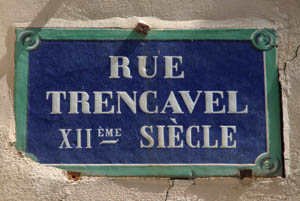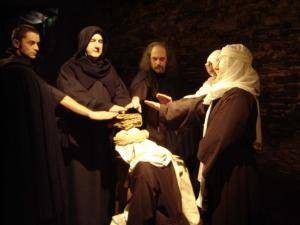Cathars and Cathar Beliefs in the Languedoc
|
| |||||||||||||||||||||||||||||||||||||||||||||||||||||||||||||||||||||||||||||||||||||||||||||||||||||||||||||||||||||||||||||||||||||||||||||||||||||||||||||||||||||||||||||||||||||||||||||||||||||||||||||||||||
|
|
|
|
|
|
||||||||||||||||||||||||||||||||||||||||||||||||||||||||||||||||||||||||||||||||||||||||||||||||||||||||||||||||||||||||||||||||||||||||||||||||||||||||||||||||||||||||||||||||||||||||||||||||||||||||||||||
|
|
|||||||||||||||||||||||||||||||||||||||||||||||||||||||||||||||||||||||||||||||||||||||||||||||||||||||||||||||||||||||||||||||||||||||||||||||||||||||||||||||||||||||||||||||||||||||||||||||||||||||||||||||||||
|
|
Source Documents: Interogation of Aude, Wife of Guillaume Fauré, of Merviel
On July 15, 1318, a twenty-six-year-old laywoman named Aude Faure was called before the Inquisition tribunal at the diocesan seat of Pamiers in the County of Foix, and immediately confessed to having temporarily doubted both the real presence of Christ in the Eucharist and the transubstantiation of bread and wine into Christ's body and blood; her doubt, she explained, had been cured by intervention from the Blessed Virgin. Less than a month later, Aude abjured her errors by the usual formula and was sentenced to a series of pilgrimages and fasts over the next three years. Aude's multiple confessions, along with depositions from her family, friends, and neighbours, take up a mere six folio pages in the Register kept by Bishop Jacques Fournier, head of the Pamiers tribunal, and preserved in the Vatican Library after Fournier became Pope Benedict XII. Aude seems to have been an ordinary woman with ordinary beliefs - including scepticism about the then century-old doctrine of transubstantiation. Such scepticism had become a capital crime, so we have no idea about whether Aude really changed her mind, or simply said what she hoped would save her life. If a stated disbelief in unicorns were sufficient cause for a death sentence, then we might expect the majority of people to be willing to avow a belief in unicorns. The prospect of being burned alive would be a strong incentive to convince authorities that one really did really, genuinely completely believe in unicorns. So it was with Catholic doctrine in Pamiers in 1318, including the doctrine of transubstantiation. Most rational people in Aude's circumstances would announce their sudden acceptance of the doctrine, and might well make up a divine vision to help bolster it. Inquisitors burned women like Aude for expressing continued doubts about Catholic doctrine. Her only chance was to renounce her doubts, and she might well have gambled that a divine vision might help tip the balance in her favour - for a bishop a vision was the best possible reason for her to change her mind. We have no idea how many people privately rejected and riduculed this Catholic doctrine in 1318 - the proportion might have been much the same as it now, but we will never know because they valued their lives. Aude's case has prompted a number of mentions in religious and quasi-historiographic works, and these mentions are striking for their ideas about Aude's doubt and miraculous vision. They do not seriously consider the possibility that Aude might be putting on an act in order to save her life. Instead she has been diagnosed as hypersensitive, neurotic, masochistic, morbid, hysterical, obsessive, afflicted with atheism, prone to fantasy, tormented by guilt, suffering from postnatal depression, and simply deviant - all views that sit comfortably with a Catholic viewpoint. At the time of writing, only Peter Biller, has suggested that Aude's case should be considered as an example of the "wide range of theological doctrine, simply and clearly held, [which] was common currency" among common people at that time and in that place.
CONFESSION OF AUDE, WIFE OF GUILLAUME FAURE OF MERVIEL
NOTES [some notes were not available in the annotated copy used in transcription] 6. anbegament = obstacle; impediment; snag; hitch
Translation by Dareth Pray, San José State University, 2006 - to whom many thanks for permission to reproduce this text.
Below is an academic paper that discusses Aude's case - without any serious consideration that her new found faith in transubstantiation might be no more than an understandable play-act by an intelligent woman, keen to save her life. Wendy Love Anderson (2006). The Real Presence of Mary: Eucharistic Disbelief and the Limits of Orthodoxy in Fourteenth-Century France. Church History, 75, pp 748-767 doi:10.1017/S0009640700111825 The real presence of Mary: eucharistic disbelief and the limits of orthodoxy in fourteenth-century France (1). On July 15, 1318, a twenty-six-year-old laywoman named Aude Faure was called before the Inquisition tribunal at the diocesan seat of Pamiers in southern France and immediately confessed to having temporarily doubted both the real presence of Christ in the Eucharist and the transubstantiation of bread and wine into Christ's body and blood; her doubt, she explained, had been cured by intervention from the Blessed Virgin. (2) Less than a month later, Aude abjured her errors by the usual formula and was sentenced to a series of pilgrimages and fasts stretching over the next three years. Aude's multiple confessions, along with depositions from her family, friends, and neighbors, take up a mere six folio pages in the famously detailed Register kept by Bishop Jacques Fournier, head of the Pamiers tribunal, and preserved in the Vatican Library after Fournier became Pope Benedict XII. This relatively quick-moving and insignificant case seems unrelated to the best-known activity of Fournier's tribunal, namely, the extinction of the last vestiges of Occitan Catharism. Yet Aude's case has gleaned several mentions in recent historiographic works, and these mentions are striking for their focus on the protagonist's psyche: she has been variously diagnosed as hypersensitive, neurotic, masochistic, morbid, hysterical, obsessive, afflicted with atheism, prone to fantasy, tormented by guilt, suffering from postpartum depression, and simply deviant. (3) Any efforts at placing the case within either an historical or a theological context have been extremely limited, with passing observations comparing Aude to her famous mystical contemporaries Angela of Foligno and Marguerite Porete, situating her errors within the context of "unsettling reflection[s]" on Christ's assumption of Mary's flesh, or cataloging her case among other "fantasies" at the margins of orthodox thought about the Eucharist. (4) Only one scholar, Peter Biller, has suggested briefly that Aude's case should be considered as an example of the "wide range of theological doctrine, simply and clearly held, [which] was common currency" among equally common people at a certain time and place. (5) The following essay will treat Aude's case from the perspective of the history of Christian spirituality and belief rather than the annals of abnormal psychology. As we shall see, Aude's dossier depicts a woman living in a climate of common interest in and expression of the ramifications of Christ's humanity. Like contemporaries ranging from Parisian schoolmen to the final generations of Cathar heretics, she had trouble reconciling her knowledge of human biology with the eucharistic doctrines codified by the Fourth Lateran Council a century earlier. But Aude's dilemma, as produced in her dossier, was ultimately resolved by a devotional appeal to the Virgin Mary, which evoked the growing late medieval interest in Mary's own conception and her role in producing the eucharistic body of Christ as well as the long-standing history of Marian intercession or miracles to demonstrate Christian orthodoxy. Far from being another example of medieval grotesquerie or even a specialized instance of doctrinal deviation, Aude's case highlights a loosely organized community of otherwise unremarkable laypeople performing relatively sophisticated mental operations in order to integrate doctrinal tensions and ongoing debates about eucharistic theology into their devotional lives. It emphasizes the elasticity of orthodox Christian belief in a time and place most famous for the persecution of heresy and depicts the complexity of late medieval Marian devotion as it intersected with both eucharistic controversy and definitions of orthodoxy. Finally, it suggests areas of overlap between Inquisitorially constructed texts and individual expressions of spirituality where historians of Christianity (medieval or otherwise) might fruitfully search for new ideas. I. THE SECRET SIN No doubt scholars have been slow to recognize the fundamentally theological nature of Aude's dilemma in part because of the difficulties posed by the source text. It is a record of testimony both translated (from Occitan into Latin, with the exception of a few phrases left in the vernacular) and coerced (at least implicitly). Obviously, it must be treated with immense caution, especially in view of the tendency of southern French Inquisitorial documents to reduce most situations to binaries of orthodoxy/heresy or belief/disbelief even as they seem to offer glimpses into otherwise undocumented areas of lay spirituality. (6) Treating this particular document as a transparent, univocal account would be impossible in any case: even a surface look at the dossier indicates that the accused offered at least two separate (and seemingly unrelated) accounts to explain how she fell into the Inquisitorial categories of "error" and "disbelief." The first version appears to be the one Aude told her husband and (in part) an in-law, or at any rate their testimony confirms it; the second version, which only came out after a week of questioning, is partially confirmed by testimony from four other women and is the one that ultimately satisfied the Inquisitors. What the two versions have in common is their precise statement of Aude's main error--disbelief in the real presence of Christ in the Eucharist--and her seemingly unverifiable claim that the Virgin was responsible for ending this disbelief. While both versions of Aude's story were necessarily constructed by some combination of the witnesses, the Inquisitors, and the translation process, it is extremely helpful to compare and contrast the two (intersecting) narratives of orthodox disbelief within Aude's dossier. Aude's first version of her fall into and deliverance from disbelief seems to be not merely constructed but tailored to an Inquisitorial audience invested in the importance of priestly and episcopal power and their outgrowth in the sacrament of confession. According to her initial confession on July 15th, Aude, daughter of the late Guillaume de Maucasal of Lafage, had married Guillaume Faure of Merviel some eight years earlier. She is identified as a pious Christian, devoid of any known association with heretics, who began her confession of faith by either asserting or repeating after her Inquisitor the belief "that Lord Jesus Christ took flesh from the Blessed Virgin Mary and was born from her" and continuing through a rough paraphrase of the Nicene Creed. (7) However, according to the Inquisitorial text, a serious sin she had committed before her marriage worried her, so that she left this sin out of her Lent confession the following year and avoided Communion at Easter by telling her husband that young people in Lafage were not accustomed to take the Eucharist. The second Easter after her marriage she did receive Communion (for the first time, if we believe her account of Lafage custom), but remained "all terrified and disturbed, because she had received the body of Christ without confessing the said sin." (8) Over the following three years, she then "fell into error," as described in the Inquisitor's text: "Although she believed that God omnipotent was in heaven, nevertheless she did not believe that this God was in the sacrament on the altar, nor that through the holy words which the priest said that there was the body of Christ." (9) She had mentioned her disbelief only to her husband and Ermengarde Garaude, her husband's aunt, (10) during a recent illness. Both Guillaume and Ermengarde had initially demanded to know whether she was in her right mind and had threatened her with expulsion from the Faure household for bringing unorthodox opinions into its midst. Once they were convinced of her good intentions, Ermengarde tried to revive Aude's belief by narrating a pious eucharistic exemplum about a woman who baked the bread [placenta] for the Host and laughed when it was consecrated, only to find herself faced with a child's finger when she took Communion. Meanwhile, Guillaume--the only person to whom Aude had mentioned her unconfessed sin--demanded that his wife confess to a priest at once. However, Aude claimed not to remember whether or not she had actually confessed the sin. (11) She had continued in disbelief, the dossier specified, until she was brought before Bishop Jacques Fournier: "in his presence she said that the Blessed Virgin Mary cast into her heart once again that she believed the sacrament of the altar to be the flesh and blood of Christ. And she believed everything else that a Good Christian man or woman ought to believe." (12) When she was called back to confirm her testimony two days later, Aude clarified that she had fallen into error immediately after she took Communion without a full confession and amended the timing of her first Communion to the first (rather than the second) year after her marriage. However, she said, she had finally confessed her secret sin to a priest from the local church of Saint-Croix during her recent illness. Guillaume and Ermengarde also testified to their parts in Aude's account, confirming her lack of any heretical associations. According to Guillaume's testimony, Aude had told him not only about her unconfessed sin, but had admitted that "when I am in church and the body of Christ is raised, I cannot pray to it nor can I behold it, but when I think to look at it, a certain glare comes before my eyes." (13) After berating his wife, Guillaume told the tribunal, he had immediately gone out and summoned the priest to whom Aude confessed; however, he had not reported her to any authorities because he believed her to be out of her rational mind from illness. (14) Ermengarde also expanded on Aude's account of their conversation, noting that she had reminded Aude that the words of eucharistic consecration were ordained by Christ, and recounting several credal prayers (in a combination of Occitan and Latin), which she herself regularly spoke during the elevation of the Host and upon awakening. (15) Despite these efforts, Ermengarde claimed, Aude remained convinced that her eternal soul was in peril due to her disbelief. After further recriminations from Ermengarde, Aude cut her face with her hands, wept, and asked Ermengarde to pray that the love of God would comfort her. Not long afterwards, Ermengarde concluded, she herself became ill from the fear of this incident and recounted it to the local priest and four convenient witnesses, all of whom in turn affirmed Ermengarde's story. At this point, the case seemed ready for closure: the sin, whatever it was, had been duly confessed, and Aude had been cured of her disbelief, with all parties vigorously professing their once and future orthodoxy. The story is picture-perfect--almost too perfect--from a doctrinal point of view. Canon 21 of the Fourth Lateran Council, held back in 1215, had mandated annual confession and receipt of Communion (preferably at Easter) as a minimum for all Christians, while enacting harsh penalties against any priest who might break the seal of the confessional; one hundred years later, the tradition of Summae confessorum and the growth of local statues mandating even more frequent confession continued to emphasize the importance of this sacrament. (16) Meanwhile, the famous first canon of Lateran IV had emphasized the connections between Catholic unity, the real presence of Christ in the Eucharist, and the apostolic tradition held by the Church's priests and bishops. (17) Over a century later, eucharistic teachings continued to create controversy, but the division of Latin Christendom into an authorized (male) clergy and a laity whose principal responsibilities were making a full confession and maintaining full faith in all the Church's doctrines remained unchanged. Aude had faltered on both counts of lay responsibility, but now--according to the Inquisition's records--she had referred her problems to the proper series of clerical authorities and reaffirmed her allegiance to orthodox belief. The seal of the confessional, which Jacques Fournier respected in other cases, probably accounts for the one remaining gap in testimony, that of the precise nature of Aude's unconfessed sin and the identity of the priest to whom she had finally confessed it. Yet something about this story must have remained unsatisfactory, either to the Inquisitors or to Aude herself, because when Aude was called before the tribunal again on July 21 "to inquire further about the truth of what had been sent forward by the said Aude," she offered a substantially different account of how her "error" came into being. (18) II. THE PUBLIC PARTURITION We have no clear indication of what caused Aude to change her story, since all the details in her initial account lined up perfectly. There is no evidence that she was subjected to or threatened with physical or psychological punishment, but it cannot be ruled out; there is also no ruling out the possibility that one of the witnesses to her second story came forward with some details that Aude had omitted. However, it is equally possible that Aude herself was unsatisfied with her Inquisitorially constructed identity as a confused and inadequately confessed victim of "error" and initiated a second round of testimonies; after all, the sentencing tribunal eventually credited her with having made a "spontaneous confession." (19) Her second story--multiply attested, as we shall see, and accepted by the tribunal as final truth--began from the same set of eucharistic errors as the first, but this time Aude admitted that they did not come from the unconfessed sin "of which mention was made above," although she had indeed failed to confess these events up until her appearance before the tribunal. (20) In the new version, her crisis had begun about four years earlier:
Three days later, on July 24, Aude was called in to confirm her new testimony, and either she or her Inquisitorial amanuensis amended the account to change the moment at which error "touched" her: "this thought of uncleanliness occurred to her [only] when the body of Christ was elevated, and she could not believe that the body of the Lord was there on the altar, nor could she herself pray or contemplate well, since she was impeded by that aforementioned thought and many other thoughts which occurred to her during the said elevation." (23) In any case, according to this new story, Aude's combined experience of recollected childbirth and eucharistic celebration--not her unconfessed sin--had created the spiritual crisis that the Inquisition defined as "error" and diagnosed as "disbelief." This is, of course, the episode that has given rise to most of the modern attempts to diagnose Aude with psychiatric disorders. From a strictly theological standpoint, however, her train of thought was eminently rational: she had just been reminded of the realities of normal human childbirth, and as an orthodox Christian (the Inquisitorial text reminds us) she believed that Christ had taken flesh from the Virgin Mary. When she saw the Host being transubstantiated into Christ's human body, it occurred to her with new force that Christ must also have been born in the human fashion with its accompanying turpitudo "that women produce during childbirth." It is unclear what Occitan word in Aude's testimony the Inquisitorial scribe might have translated as turpitudo, but the term definitely implies an association of childbirth with something more than simple messiness or unpleasantness, and the emotionally fraught context in which the word turpitudo appears argues that the association was Aude's rather than the scribe's. Aude's crisis may be difficult for contemporary readers to sympathize with, but it is hardly pathological viewed in historical perspective: the connection between childbearing and impurity in Christian thought ultimately dates back to the Hebrew Bible Book of Leviticus, and the connection between female fertility and sin was further attested by then-traditional Christian readings of God's curse upon Eve in Genesis 3:16. (24) At the same time, medieval medical authorities debated whether the blood that nourished the fetus and was expelled along with it was simply retained menstrual blood--a substance that was not merely symbolically and theologically impure, but biologically superfluous and quite literally poisonous to a variety of living creatures--or a boiled, purified version of that same blood. (25) Aude herself had very probably given birth at least once; in any event, it is clear from her testimony that she had witnessed childbirth and was able to paint a vivid mental picture of its aftermath. (26) She would certainly have been familiar with the medical and spiritual associations of childbirth from attending other family births, from sermons, from conversations, from popular stories, or even from the widespread "churching" rituals aimed at purifying women after childbirth.(27) She would also have been familiar with the eucharistic program of Lateran IV, which seemed to set these associations into direct conflict with Catholic orthodoxy. Indeed, Aude was not the first--much less the only!--medieval Christian to puzzle over how the simultaneously human and divine Christ could be made present in any sense in the all-too-mundane Host. Both Lafage and Merviel were "Catholic" towns, as Ermengarde Garaude's exemplum suggests, but in other parts of Languedoc the Cathar heresy hung on with unexpected (if ultimately doomed) vigor, teaching that Aude's problem could only be solved by cutting the Gordian knot, assuming a completely divine Christ and associating human reproduction (indeed, human bodies) with an evil deity. (28) Nor was Cathar influence necessary to raise doubts in the minds of ordinary Catholics about the miracle of the Eucharist. Villagers in Jacques Fournier's Register who seemed entirely unaffiliated with heretical movements questioned the supernatural and invisible presence of Christ in the Host and repeated the well-worn observation that Christ's body must be the size of a mountain if people were still eating it. (29) Aude herself was never seriously suspected of heresy, either in the strict canonical sense of obstinately held error or in the historical sense of organized dissent from the Church, and her dossier offers no evidence of a naturally skeptical frame of mind. Indeed, Aude's translated vocabulary bespeaks not only Catholic orthodoxy but also a certain theological sophistication when we compare it to other testimonies in Fournier's dossier: while she is credited with identifying the consecrated Host correctly as "the body of our Lord," Le Roy Ladurie has pointed out the extent to which many of Aude's contemporaries, especially those from the lower classes, were recorded referring to the Host simply as "Christ." (30) But even if Aude herself could probably distinguish between Christ-as-God and Christ's body, she still lived in an environment where the two were often elided, and where--as Sarah Beckwith has pointed out in another context--"Christ's body is less the forum for integration and social cohesion than the forum for social conflict, the very arena and medium of social argument." (31) After all, while Guillaume Faur6 had briefly wondered if his wife was temporarily out of her mind, he had also accused her of being "cursed," and his aunt had simply identified her as a "traitoress" who had brought heresy into the family home. (32) No wonder Aude's problem was not so easily diagnosed, by her family or by the Inquisition: it represented one facet of an extremely complex, much-vexed historical discourse about how the sacrament was being adapted or adopted into the lives of fourteenth-century Christians. The equally strong theological conflict between an orthodox Christology in which Christ was "born of the Virgin Mary" and the Church's teachings about the inherent uncleanliness and sinfulness associated with childbearing--that is, the particular incident that prompted Aude's eucharistic disbelief--was also nothing new. Half a century earlier, in the Summa theologiae, Thomas Aquinas had argued for the distinction between a "purified blood" that sustained the human embryo, and its impure residue, female menstrual blood, for a very specific reason: it lessened the distance across which he had to argue for Christ's completely pure conception.
Aquinas did not tackle the issue of Mary's delivery, but over the next centuries his Dominican confreres found themselves spearheading opposition to the increasingly popular notion that Mary herself had been conceived immaculately precisely by emphasizing her participation (however voluntary) in the menstrual cycle: since breast milk was also perceived as deriving from superfluous menstrual blood, they sponsored images of lactating Virgins in churches across Europe. (34) Of course, discussion of the Virgin's puerperal purity was also taking place on a less technical level, as part of a narrative tradition that had existed since at least the second century C.E. and the Protevangelium of James. (35) The fifteenth-century English N-Town Play offers testimony from Mary's (apocryphal) midwife on precisely the point that so bothered Aude:
These examples only begin to suggest the extent to which Mary's distinctively female body and her role as Christ's human mother stood at the center of both theological and popular disputations throughout the late Middle Ages. As Rachel Fulton has pointed out in reference to a slightly earlier period, "praying to the Virgin and her crucified Son forced medieval Christians to forge new tools with which to feel." (37) Nor was Aude's leap from human motherhood to the Host entirely without precedent in the history of Christianity. Up through the twelfth century, Fulton notes, Mary (unlike her son) "was present at the altar only virtually, in the remembrance of the fact that the same body available on the altar had first taken its substance from her own." (38) But even then, and increasingly into the late Middle Ages, connections were inevitably drawn between the Virgin and the Eucharist, since both were powerful symbols of Christ's humanity, and both--often together--had become crucial to an era of devotion to and controversy over the ramifications of that humanity. This symbolic association was reified in popular art and literature: Mary was variously depicted or imagined as the tabernacle, vessel, container, robe, and clothing of Christ. She could also be cast as the celebrant of the Mass, the miller of the eucharistic grain, and the oven in which the Host was baked--this last very much in keeping with Galenic theories of conception in which the mother served only as a source of heat (a literal "oven") for the fetus. (39) And, of course, the figure of Mary holding the infant Christ--sometimes suckling her now demonstrably human son--was both central to and ubiquitous in the new eucharistic altarpieces that emerged in the aftermath of Lateran IV's liturgical reforms. In some of these representations, Mary's lactation became explicitly eucharistic, offering her breast in parallel to a bleeding Christ offering his wound. Indeed, Caroline Walker Bynum has pointed out that Christ's crucified body was itself "feminized" by its leakages of blood/milk and water, making the parallel between the Virgin and the Eucharist even stronger. (40) Bynum also draws attention to assorted mystical visions that link the two concepts: for instance, the German nun Lukardis of Oberweimar (d. 1309), too weak to attend Mass, saw Mary appear with her child and nurse Lukardis in lieu of Communion. (41) An even stronger association between Mary and the eucharistic celebrant appears in the visions of the Austrian beguine Agnes Blannbekin (d. 1315), who envisioned the Virgin touching the Host with one finger and was immediately "given to understand" that "the finger of the Blessed Virgin symbolizes the officiating priest because, as the Blessed Virgin brought the Savior physically into the world and presented him, so does the officiating priest bring him and other sacraments to the people." (42) Aude was no holy woman, and her case may seem miles away from these contemporary visions in more than geographic terms, but even in her dossier there is one easy association of the Virgin's body and Christ's (similarly fluid) Passion in a eucharistic context. Aude's "aunt," the self-consciously orthodox Ermengarde Garaude, had testified that her own customary prayer at the elevation of the Host ran as follows: "Lord, true God and true man, all-powerful, who was born of the body of the Virgin Mary without any sin.... Lord, whose side was pierced by a lance from which came forth blood and water by which we were redeemed from sins, bring me a tear of your water which washes my heart of all ugliness and of all sin." (43) Here the middle point between Virgin and Eucharist is their common interest in Christ's suffering yet sinless flesh. Throughout Aude's dossier as well as the wider context of late medieval spirituality, then, the Virgin and the Eucharist are linked by their mutual effusion of bodily fluids and their mutual (and miraculous) production of the human body of Christ. However, Ermengarde's prayer also demonstrates the extent to which both Virgin and Eucharist served as touchstones for Christian orthodoxy, and it is here that the successive stories of Aude's dossier display their clearest signs of doctrinal as well as devotional thoughtfulness. While every possible reading of the Inquisitorial text indicates that Aude was not (in any sense) a heretic, she had--as the scribe repeatedly emphasizes--"erred." As such, she was eligible to take advantage of yet another facet of late medieval Marian spirituality: the Virgin providing evidence (miraculous or otherwise) to bolster orthodoxy and eliminate the doctrinal problem of disbelief, especially on matters pertaining to Christ's incarnate flesh. Some of the best-studied examples of this phenomenon pit Mary against the classically "unbelieving" Jews: in miracle stories dating back as far as the sixth century, Mary intervenes precisely in order to convince Jews of the real presence of her son in the consecrated Host, or occasionally in order to spotlight alleged Jewish perfidy in dealing with the Eucharist for the benefit of local Christians. (44) Equally common are the Marian miracle stories in which the Virgin saves orthodox Christians who have fallen into much more serious "errors" than Aude's: one of the most famous is the Theophilus legend, in which Mary successfully redeems the soul an ambitious cleric had previously sold to the Devil! (45) Closer to Aude, there are numerous examples of Marian devotion being demonstrated, questioned, or denied throughout the other dossiers in Fournier's Register; Kathrin Utz Tremp notes that some of the denials are traceable directly to Cathar concerns about the Incarnation--another case of Inquisitorial "disbelief." (46) Within the discourse of Aude's dossier, then, as well as the larger discourse of late medieval Christendom, it followed that where orthodoxy was questioned and confession (to either priest or Inquisitor) was impossible or simply insufficient, Mary was the appropriate object of prayer and invocation. And so the seemingly gratuitous insertion of Aude's salvation by the Virgin--a feature of her initial story that appeared in the very earliest version of her testimony--became not only theologically central to her newly framed dilemma but practically necessary as a method for demonstrating that Aude's Inquisitorially diagnosed disbelief had indeed been "cured." If the Virgin had truly interceded for her, Aude must now be "orthodox" by Bishop Jacques Fournier's standards as well as by her own. III. THE IMMACULATE INTERVENTION This is, of course, precisely how Aude's dossier continues its revised narrative. As Aude explained in her testimony of July 24 (reiterated and slightly amended twice more), her husband had hired a nurse during her own recent illness. The nurse, Alazais de Pregolh, became ill in her turn, and she arranged for the Eucharist to be brought her on her sickbed. Aude watched Alazais receive the Host, and after the priest had left, Aude returned to the room where Alazais lay accompanied by two widows from Merviel. (47) When the other women touched Aude's body, she "began to be disturbed and to move herself" (that is, in convulsions). (48) Her later deposition added--perhaps with an eye toward Inquisitorial propriety--that she had cried "Holy Mary, help me!" and then complained of not having confessed properly. (49) At any rate, the widows reassured her that she was known throughout the town for her charity and asked what sin she could possible have committed; Aude told them that she could not believe in God, to which they responded, Holy Mary, what are you saying! Return to God and have hope in him!" (50) After the two women left, Aude returned yet again to her nurse's room and asked Alazais whether she believed that she had received Christ's body. When Aude got an affirmative answer, she asked Alazais: "How can it be that I cannot believe?" Alazais responded: "Lady, return to God and believe constantly that this is the body of Christ." Aude asked the nurse to pray that "God might put in her heart that she would believe," and while the nurse prayed, Guillelma, Aude's maidservant, entered the room. Aude asked her, "Guillelma, put yourself in prayer and ask the Blessed Virgin Mary of Montgauzy to illuminate me so that I may believe in God." When Guillelma began praying to the Virgin of Montgauzy, "suddenly the said Aude became, as she says, illuminated, and she believed constantly in God, and she believes it still as she says it." (51) Was Mary really the inevitable answer to Aude's dilemma? Aude and her contemporaries were far from naive: many of the relatives, friends, and acquaintances to whom Aude divulged her difficulties initially suspected that she suffered from medical or psychiatric problems, although she was able to convince most of them that she was not ill. (52) Instead, they suggested an array of theological (and occasionally thaumaturgical) solutions: confession, credal prayer, edifying stories, and appeal to higher powers. Contemporary readers familiar with the history of late medieval Christian spirituality can offer additional possibilities: Aude's disbelief could have been cured, as in Ermengarde's exemplum, by a simple vision of Christ's literal body replacing the consecrated Host. She could have confessed to a priest and received doctrinal reassurance about the stainless nature of Christ's nativity with only glancing references to the Virgin Mother. She could, presumably, have gotten involved with some sort of organized or informal community that affirmed her denial of Christ's real presence in the Eucharist. She did none of these things--or, at any rate, she did not choose to share them with the Inquisition. Prayer to Mary was the option upon which both Aude and the Inquisitors seem to have seized, the most appropriate answer for her underlying concern with childbirth-related turpitudo as well as for her ongoing entanglement with Fournier's tribunal. Whether or not Aude was finally telling the truth, she was certainly telling a truth, at least within the textual boundaries of her dossier. Her new set of witnesses confirmed their parts in the story, and Fournier--a skilled canonist and theologian, advised by a panel of local religious--was certainly convinced by it. The penitential regime to which Aude was sentenced on August 7 makes it clear that Fournier considered her transgression relatively minor and that he credited the Virgin with her return to orthodoxy: Aude was not only to confess to her priest four times a year and report to the bishop or his successor every St. Anthony's Day and every Corpus Christi, but also to fast on bread and water on the vigil of each festival of the Virgin Mary and on every Friday that did not fall on Christmas, a festival of the Virgin Mary, or All Saints for the next three years. (53) During the same three-year span, she was to make one pilgrimage each year to each of three different Marian churches in the region and continue to visit the church of the Virgin of Montgauzy each year. (54) Fournier's sentence also confirms his awareness of Aude's multiple stories. Indeed, an unusual postscript to the sentence states that Guillaume Faure is to be cleared of any wrongdoing, presumably as an acknowledgment that Guillaume had testified in good faith despite the differences in his and his wife's ultimate explanations (or, perhaps, had succeeded in convincing the tribunal that this was the case). (55) Fournier also asserted that the Inquisition would press charges against "aforementioned women" who had committed perjury in Aude's case, possibly false informers against her. (56) Aude herself was decidedly in the clear as regarded the tribunal, which concluded that "now she believes with good heart and faith, just as she asserts, that the body of Christ is not imaginary but truly in the sacrament of the altar." (57) Of course, the Inquisition--even one as effective as Fournier's--had been outwitted before, and would be again. During the past ninety years of Languedocian inquisitions, those being questioned had made use of strategies as obvious as flight and as subtle as resort to allegory. (58) But if Aude's final story was a fabrication of some sort, it was a remarkably clever and coherent one, buttressed by considerable supporting testimony. The final narrative element that makes the link between Mary and the Eucharist throughout all the stories not only workable but seemingly inevitable, Aude's overhearing of gossip and consequent recollection of the turpitudo of childbirth, seems to have been mentioned only in front of Fournier's tribunal--yet its internal logic makes it the most compelling and comprehensible part of the entire dossier. If it was a reasonable approximation of the truth, on the other hand, why all the other versions? They seem to delineate the various social and discursive communities through which Aude worked to resolve her dilemma. With the local widows, it seems, Aude was extremely (and perhaps understandably) vague, describing her problem in general terms of disbelief in God and failure to confess that. With "Aunt" Ermengarde, an in-law of sorts, and with her servants, Aude admitted her eucharistic disbelief but refused to divulge a source (or, quite possibly, they refused to admit to hearing about it). Only the immediate members of Aude's household--husband, courtesy aunt, and servants--heard about the specifically eucharistic nature of her disbelief, and only the servants--tower-status women outside Aude's husband's family, perhaps not inclined to judge her as readily as Ermengarde had--seem to have been involved with the invocation of Mary to "illuminate" Aude. As for the tale of the "secret sin" leading to eucharistic disbelief, it seems likely that this was either the explanation Aude had offered her husband (and possibly the priest from Saint-Croix whom he had summoned) or Guillaume's own preferred version of events in which he himself took decisive action to help his wife--perhaps around the same time that the women in her community were beseeching Mary to help her. (59) It might even have represented a sort of collaboration between Aude and Guillaume, designed to appeal to a range of male authority figures, including Fournier's tribunal, and carefully tailored to pose as little challenge as possible to orthodoxy. We can hypothesize, then, that Aude distinguished between her assorted confidants by household ties, social standing, and perhaps gender; insofar as we can deduce from the Inquisitorial text, she may have withheld or embroidered parts of her account to suit each community of interlocutors. But when the entire Inquisitorial text is viewed as a whole, what emerges is a picture of a woman with deep spiritual concerns, lacking in any formal education (as far as we know) but capable of addressing doctrinal dilemmas via a series of relatively sophisticated theological and devotional maneuvers that ultimately met with approval from a panel of trained theologians. We are also left with the awareness that this woman existed within a number of overlapping discursive communities, many of whom immediately recognized the difficulties posed by both orthodox eucharistic doctrine and Inquisitorially defined orthodoxy itself, as well as the usefulness of appeal to Mary's unique status under those circumstances. The Virgin's power transcended both gender and class: while Aude's dilemma may have been created and solved in an all-female and lay environment, the clerically educated Bishop Fournier was apparently able both to evoke it and to appreciate it. And despite the Inquisitorial language of belief and doubt, error and orthodoxy, we can also be certain that Aude and her neighbors understood and acknowledged Mary as a powerful intercessory force with respect to precisely the sort of theological issue--eucharistic orthodoxy--in which the Virgin had become a locus for both conflict and resolution. Mary's invocation by the Merviel community and her direct involvement in Aude's case indicates the presence of a highly specific and sophisticated current of Marian eucharistic spirituality, one which Aude, her servants, and even Bishop Fournier credited with her cure. Moreover, Mary's invocation in the context of Aude's dossier--the proof that her Catholic orthodoxy was being questioned--reminds us that Marian devotion could also serve as evidence of "right" belief despite considerable evidence of other doubts, fears, and omissions. Taken together, these developments suggest the extent to which a Christian community could draw on the multivalent Virgin to resolve contradictions in not only their understanding of doctrine but also in their experience of belief and disbelief. To argue that Aude's concerns with turpitudo represent a neurotic fantasy, an "obsession," or some other problematic diagnosis is to ignore the theological complexity and social agency involved in the invocation of the Virgin Mary throughout Aude's dossier. Aude's multiple narratives, and the various communities within which her stories were constructed, ultimately test the limits of historical awareness as well as the boundaries of late medieval Christian orthodoxy.
Notes (1.) This article has gone through several stages of revision: I would like to thank Dr. Lucy Pick of the University of Chicago, Dr. James Ginther of Saint Louis University, and the 2002-3 Erasmus Institute Fellows at the University of Notre Dame for comments and suggestions. I would also like to thank my anonymous readers for Church History for their careful and constructive critiques. Any remaining infelicities or errors are, of course, my own. (2.) Aude's dossier has been edited in Le Registre d'inquisition de Jacques Fournier, eveque de Pamiers (1318-1325), ed. Jean Duvernoy (Toulouse : Edouard Privat, 1965), 2:82-105 (hereinafter "Duvernoy" followed by volume and page numbers). (3.) Cf. Emmanuel Le Roy Ladurie Montaillou, village occitan de 1294 a 1324 (Paris: Gallimard, 1975; corr. ed., 1982), 532-34; Peter Dronke, Women Writers of the Middle Ages: A Critical Study of Texts from Perpetua ([dagger] 203) to Marguerite Porete ([dagger] 1310) (Cambridge: Cambridge University Press, 1984), 214-15; and Miri Rubin, Corpus Christi: The Eucharist in Late Medieval Culture (Cambridge: Cambridge University Press, 1991), 342-43. (4.) These are, respectively, Dronke, Women Writers; Caroline Walker Bynum, Holy Feast, Holy Fast: The Religious Significance of Food to Medieval Women (Berkeley: University of California Press, 1987), 266; and Rubin, Corpus Christi. (5.) Biller, "The Common Woman in the Western Church in the Thirteenth and Early Fourteenth Centuries," in Women in the Church, ed. W. J. Sheils and Diana Wood (Oxford: Basil Blackwell, 1990), 145. (6.) My own reading of Aude's dossier has been heavily informed by John Arnold's emphasis on the discursive and textual nature of the increasingly complex fourteenth-century Inquisitorial records, and the resultant "production" of heresy. These concepts are elaborated in Arnold's Inquisition and Power: Catharism and the Confessing Subject in Medieval Languedoc (Philadelphia: University of Pennsylvania Press, 2001), and Belief and Disbelief in Medieval Europe (London: Hodder Arnold, 2005). In Aude's case, we can see the very conscious "production" of orthodoxy even in a situation relatively far removed from organized heretical movements. (7.) Ibid., 82: "Auda statim dixit et respondit quod credebat dominum Jhesum Christum carnem suscepisse de Beata Virgine Maria et natum fuisse ex ea, ipsum passum et crucifixum pro genere humano fuisse, et resurrexisse et celos ascendisse, venturum etiam ad iudicandum bonos et malos, et quod profitebatur et credebat fidem et sacramenta prout tenet sancta romana Ecclesia." (8.) Ibid., 83: "stabat, ut dixit, tota perterrita et turbata, quia receperat corpus Christi sine confessione dicti peccati." Following Duvernoy, I have chosen to render names of persons and places in the vernacular whenever possible. Aude's husband's name is Guillelmus Faber in the Register, and the town in which they lived is Muro Veteri; Aude herself came from the town of Fagia. (9.) Duvernoy, 2:83: "videlicet quod licet crederet quod Deus omnipotens esset in celis, tamen non credebat quod ille Deus esset in sacramento altaris, nec quod per verba sancta que dicit capellanus, esset ibi corpus Christi." (10.) Aude addresses Ermengarde as tia, "aunt," in her report of their conversation on 82-83, but Ermengarde testifies that she is not related to Aude on 87. However, both Aude and Ermengarde agree that Ermengarde warned Aude against bringing heresy into their ostal, the (patrilineal) extended-family residence. Since Ermengarde is ideni tified as being from Merviel (like Guillaume, but unlike Aude), she is almost certainly a relative of the Faures and a representative of Aude's in-laws. "Aunt" could be either literal or a courtesy title. (11.) Duvernoy, 2:82-83. (12.) Ibid., 83: "in cuius presencia dixit quod de novo Beata Virgo Maria inmiserat in cor suum quod credebat in sacramento altaris esse carnem et sanguinem Christi. Et omnia alia credebat que bonus christianus seu bona christiana debebat credere." (13.) ibid., 85: "'Nam quando sum in ecclesia et elevatur corpus Christi, non possum orare ipsum nec possum ipsum respicere, set quando puto respicere ipsum, supervenit quoddam anbegament ante occulos.'" Dronke, Women Writers, 273-74, suggests amending Duvernoy's anbegament to essbegament, corresponding to Mid. Provencal esbayment or esbleougissament and Mod. Fr. eblouissement ("glare" or "dazzle"). (14.) Duvernoy, 2:85-86. (15.) ibid., 87. (16.) For instance, the 1229 Council of Toulouse had mandated confession three times a year (Easter, Pentecost, and Christmas) for the Christians of southern France; cf. J. D. Mansi, Sacrorum concilorum nova et amplissima collectio (Florence: Antonii Zatta Veneti, 1759-98), 24:197. The Lateran IV canon is number 21, Omnis utriusque sexus. For a brief discussion of how this canon influenced late medieval confessional practices, cf. John Bossy, "The Social History of Confession on the Eve of the Reformation," The Royal Historical Society, 5th ser., 25 (1975): 21-38. (17.) Lateran IV, Canon 1, De fide catholica. (18.) Duvernoy, 2:94: "dictus dominus episcopus volens plus inquirere cum dicta Auda veritatem super premissis, fecit dictam Audam coram se adduci." (19.) Ibid., 103: "confessa fuit spontanea." (20.) Ibid, 94: "peccati de quo est facta mentio superius," and 98 on her failure to confess her error of disbelief. (21.) I have chosen to translate turpitudo here as "uncleanliness," although in this context it appears to specifically describe the afterbirth and other emissions associated with a normal delivery. However, this English word fails to convey the sense of pollution that accompanies the Latin. Dronke (cf. above) chooses to translate turpitudo as "disgusting afterbirth." Since this is a pivotal term in Aude's testimony, I will be resorting to the Latin turpitudo at certain points later in this article. (22.) Duvernoy, 2:94: "contigit enim sibi, ut dixit, quod cum quadam die iret ad ecclesiam Sancte Crucis ad missam audiendam, audivit a quibusdam mulieribus, de quarum nominibus dixit se non recordari, quod nocte precedenti quadam mulier quandam filiam [Duvernoy adds 'pepererat'] in via intus castrum de Muro Veteri, ita quod non potuerat pervenisse ad hospicium, quo audito cogitavit turpitudo quam emittunt mulieres pariendo, et cum videret elevari in altari corpus Domini, habuit cogitationem ex ilia turpitudine quod esset infectum corpus Domini, et quod et [Duvernoy corrects to 'ex'] hoc inicit in dictum errorem credentie videlicit quod non esset ibi corpus Domini Iesu Christi." (23.) Ibid. (italics mine): "tamen occurrebat sibi illa turpis cogitatio quando elevabatur corpus Christi, et non poterat credere quod corpus Domini esset ibi in altari, nec poterat ipsum rogare nec inspicere bene, inpediente ipsam cogitatione predicta et multis aliis cogitationibus que sibi in dicta elevatione occurrebant." (24.) Twenty-three of the thirty-two occurrences of turpitudo in the Latin Vulgate come from Leviticus; perhaps the most telling one in this context is Lev. 20:18: "Qui coierit cum muliere in fluxu menstruo et revelaverit turpitudinem eius ipsaque aperuerit fontem sanguinis sui interficientur ambo de medio populi sui." Cf. Charles Wood, "The Doctors' Dilemma: Sin, Salvation, and the Menstrual Cycle in Medieval Thought," Speculum 56 (1981): 713: "By sin not just death entered the world, but also fertile carnality; and in women ... menstruation was both a mark of that sin--the curse of Eve--and the necessary companion of their fertility." (25.) Often, the distinction between ordinary menstrual blood and its purified form was made precisely because medieval physicians could not imagine that the vulnerable fetus could survive sustained exposure to the former. A tripartite distinction was also possible, in which the menses of pregnant women were divided into a purified portion (which later sustained the child as breastmilk) and a "superfluity" (of an already superfluous substance), which was supremely corrupt and was expelled as afterbirth. Cf. William F. MacLehose, "Nurturing Danger: High Medieval Medicine and the Problem(s) of the Child," in Medieval Mothering, ed. John Carmi Parsons and Bonnie Wheeler (New York: Garland, 1979), 3-8. (26.) Fournier's dossier tells us that she had been married for eight years, and that (as we shall see) when Aude became ill, her husband hired a nutrix who stayed on after Aude recovered. It is extremely likely that the woman was hired as a wet-nurse for a child of Aude's. It is, however, something of a leap to argue from there that Aude was suffering from postpartum depression, as does Rubin in Corpus Christi, 343-44. (27.) The extent to which late medieval churching rituals ritually performed and thereby reinforced gender roles has most recently been discussed (using northern French liturgical texts) by Paula M. Rieder, "Insecure Borders: Symbols of Clerical Privilege and Gender Ambiguity in the Liturgy of Churching," in The Material Culture of Sex, Procreation, and Marriage in Premodern Europe, ed. Anne L. McClanan and Karen Rosoff Encarnacion (New York: Palgrave, 2002), 93-113. As Rieder points out, "the churching of women not only communicated pollution but actually produced women polluted by the processes of conception and childbirth .... The frequent repetition of the rite assured that the constructed category of sexual pollution and the image of women, in particular, as the harbingers of that pollution remained constant elements in the medieval discourse on sexuality": 99. (28.) A good summary of these intertwined principles appears in Malcolm Lambert, The Cathars (Oxford: Blackwell, 1998), 161-64. (29.) Cf. Duvernoy, 1:215 ft., 3:464, and 2:130, among others. (30.) Le Roy Ladurie, Montaillou., 480, n. 3. (31.) Beckwith, Christ's Body: Identity, Society, and Culture in Late Medieval Writings (London: Routledge, 1993), 35. (32.) Cf. above, note 11. Guillaume's comment is on Duvernoy, 83: "Quomodo, maledicta, loqueris in bono sensu tuo?" Ermengarde's is ibid., 87: "Co, na traytoressa no sia, nam iste locus et istud hospitalium semper fuit mundus de tot male nec de yregia!" I thank the Church History reader who brought these conflicting diagnoses to my attention. (33.) Thomas Aquinas, Summa Theologiae Ilia a.31 q.5. Danielle Jacquart and Claude Thomasset, Sexuality and Medicine in the Middle Ages, trans. Matthew Adamson (Princeton, N.J.: Princeton University Press, 1988), 76 77, cite this passage and point out that Aquinas supports the more typical equation of menstrual blood, afterbirth, and female semen in his Sentences commentary; here he is clearly bending as many rules as possible for Mary. (34.) Cf. Wood, "The Doctors' Dilemma," 718-24. (35.) Cf. New Testament Apocrypha, 2nd edition, ed. Wilhelm Schneemelcher, English trans. ed. R. McL. Wilson (Louisville, Ky.: Westminster John Knox, 1991), 1:421-39. (36.) Edited in Stephen Spector, The N-Town Play, 2 vols., Early English Text Society S.S. 11 (Oxford: Oxford University Press, 1991), 1:160. Recent scholarship on late medieval English mystery plays has pointed out the extent to which many of these dramas create new scenes where Mary's pure, painless, and pollution-free conception and delivery of the infant Jesus can first be doubted and then be attested by witnesses. Cf. Theresa Coletti, "Purity and Danger: The Paradox of Mary's Body and the En-gendering of the Infancy Narrative in the English Mystery Cycles," in Feminist Approaches to the Body in Medieval Literature, ed. Linda Lomperis and Sarah Stanbury (Philadelphia: University of Pennsylvania Press, 1993), 65-95. (37.) Rachel Fulton, From Judgment to Passion: Devotion to Christ and the Virgin Mary, 9001200 (New York: Columbia University Press, 2002), 197. (38.) Ibid., 245. (39.) Cf. Rubin, Corpus Christi, 142-45. (40.) Bynum, Holy Feast, 102-3. But the Virgin's soothing lactation could also be contrasted to, or explicitly divorced from, her own lower body with its far more disturbing effusions, as Aude's story makes clear. On the "partition" of Mary's body, cf. Dyan Elliot, Fallen Bodies: Pollution, Sexuality, and Demonology in the Middle Ages (Philadelphia: University of Pennsylvania Press, 1999), 114-16. (41.) Ibid., 131. (42.) Agnes Blannbekin, Life and Revelations, chap. 42, trans. Ulrike Wiethaus, in Agnes Blannbekin, Viennese Beguine: Life and Revelations (Cambridge: D.S. Brewer, 2002), 40. The original Latin is in Leben und Offenbarungen der Wiener Begine Agnes Blannbekin, ed. P. Dinzelbacher and R. Vogoler (Goppingen: Kummerle, 1994), 128-30. (43.) Duvernoy, 2:86: "'Senher, veray Dieus e veray horn, tot poderos, que naquestz del corse de la Verges Maria ses tot peccat, e presestz mort e passio sus l'aybre de la veray crstz et fostz per las mas e pels pes clavelastz e per le cap de espinas coronat, e pel costat de lansa nafrat, don esshic sane et ayga, don tostz em rezemitz de peccat, Senher, trametestz me una lagrema de aquela vostra ayga que lave le mieu cor de tota legesa et de tot peccat.'" (The Occitan of this prayer suggests that it is one of the few elements of Aude's dossier which experienced a minimum of Inquisitorial translation.) (44.) These developments are discussed in more detail by Denise Despres, "Mary of the Eucharist: Cultic Anti-Judaism in Some Fourteenth-century English Devotional Manuscripts," in From Witness to Witchcraft: Jew and Judaism in Medieval Christian Thought, ed. Jeremy Cohen, Wolfenbutteler Mittelalter-Studien 11 (Wiesbaden: Harrassowitz, 1996); and Miri Rubin, Gentile Tales: The Narrative Assault on Late Medieval Jews (New Haven, Conn.: Yale University Press, 1999), 7-28. (45.) For some of the earliest variants of this legend, cf. G. G. Meersseman, Kritische Glossen op de Griekse Theophilus-Legende (7 eeuw) en haar latijnse Vertaling (9 eeuw) (Brussels: Paleis der Academien, 1963). (46.) Kathrin Utz Tremp, "'Parmi les heretiques': la Vierge Marie dans l'inquisition de l'eveque Jacques Fournier de Pamiers (1317-1326)," in Marie: Le culte de la Vierge dans la societe medievale, ed. Dominique Iogna-Prat, Eric Palazzo, and Daniel Russo (Paris: Beauchesne, 1996), 533-60. (47.) Aude seems to have been either deliberately vague or confused about the location and timing of this episode, initially thinking it had all taken place at her own house, but later amending her testimony to state that the nurse was staying at one of the widows' houses initially and that the widows came over to Aude's house later on to visit her, whereupon they discovered Aude's distress. (48.) Duvernoy, 2:95: "dicta Auda incepit turbari et moveri." The nurse Alazais de Pregolh's testimony is slightly more precise about Aude's symptoms: according to her, when the Host was being presented, "incepit molestari et clamari ac expoliari se raubis suis, et tunc dicta Aladaycis et Guillelma, pedisseca dicta hospicii dicte Aude, credentes, ut dixit, quod dicta Auda pateretur tunc morbum caducum Santi Pauli": 100. It seems as though the onlookers thought Aude might be suffering from some form of epilepsy or other convulsive disease. (49.) Duvernoy, 2:98: "Sancta Maria, succurre michi!" This version makes clear that the unconfessed sin was Aude's disbelief, not the "secret sin" of her earlier confession. (50.) Ibid., 95: "dicens ad interrogationem dictam duarum mulierum que eandem interro-gabant quare sic turbabatur et movebatur, que dixit quod pro eo quia non poterat credere Deum, que mulieres dixerunt ei: 'Sancta Maria, quid dicitis, revertamini ad Deum et habeatis spem in eo!'" (51.) Ibid., 95: "Postque cum dicte due mulieres recessissent, ipsa Auda rediit ad cameram ubi iacebat dicta nutrix et dixit sibi: 'Tu recepisti corpus Christi, credis quod illud quod recepisti sit corpus Christi?' que nutrix respondit quod credebat firmiter, cui dixit dicta Auda: 'Quomodo potest esse quod ego non possim credere?' et dicta mulier dixit ei, 'Domina, revertamini ad Deum et credatis firmiter illud esse corpus Christi.' Et dicta Auda dixit dicta nutrici quod rogaret Deum quod poneret in corde suo quod crederet, et dum dicta nutrix, ut melius poterat, rogaret Deum, supervenit Guillelma, ancilla dicti hospicii dicta Aude, cui dixit dicta Auda: 'Guillelma, pone te in orationem et roga Beatam Virginem Mariam de Monte Gaudio ut illuminet me quod ego possim credere Deum.' Quod et fecit dicta Guillelma flexis genibus. Et cum orasset, statim dicta Auda fuit, ut dixit, illuminata, et credidit firmiter in Deum, et credit adhuc prout dixit." The church of Notre-Dame de Montgauzy or Montjoie, an Augustinian Priory in the County of Foix, was a major regional pilgrimage site from at least the eleventh century forward; another woman in Fournier's Register made a pilgrimage there to request the return of her stolen property (Duvernoy, 1:192-97), so it seems likely that the Virgin of Montgauzy was also locally renowned as an intercessor. Unfortunately, the church Aude and Guillelma had in mind was destroyed in the late sixteenth century during the Wars of Religion, so we cannot speculate about whether any particular imagery might have made the Virgin of Montgauzy especially receptive to Aude's plight. Cf. Jules de Lahondes, Les eglises des pays de Foix et de Couserans (reprint Nimes: C. Lacour, 2001). (52.) The only exception, Aude's husband Guillaume, claimed that his continued belief in her temporary insanity was the reason he had failed to inform the Inquisition of her fall into error (cf. above). There is ample reason to suspect an element of self-interest in this diagnosis. (53.) Duvernoy, 2:103-4. Aude was to confess at Easter, Pentecost, All Saints, and Christmas; as her earlier testimony suggests, the custom in Merviel would have been to confess and receive Communion only at Easter. (54.) Ibid., 104. The three churches in question were Notre-Dame de Rocamadour, NotreDame du Puy, and Notre-Dame de Vauvert. (55.) Ibid, 105. (56.) Ibid.: "Item, retinemus nobis potestatem quod supranominate mulieres que superios in processu periurium commiserunt possimus de dicto periuriu punire, penitencias eisdem iniungendo et alias prout nobis placeurit et visum fuerit faciendum." Aude herself is the only woman in her dossier who seems to have substantially altered her testimony during her trial, and she is certainly the only woman supranominate throughout the sentencing phrase, unless we are to count the Virgin Mary! All the other women who testified in her case seem to have done so truthfully, judging from their conformity to Aude's reports of the same exchanges. I can only suggest that Fournier might have been referring to the one remaining omission in the dossier, the identity of the person or persons who brought Aude's case to the Inquisition's attention in the first place. (57.) Duvernoy, 2:103: "nunc se meliori consilio usa credit prout asseruit de corde bono et fide non ficta corpus Christi esse vere in sacramento altaris." (58.) For more on these strategies, cf. Arnold, Inquisition; and James B. Givens, Inquisition and Medieval Society: Power, Discipline, and Resistance in Languedoc (Ithaca, N.Y.: Cornell University Press, 1997), 93-110. (59.) On the differences between men's and women's--and especially husbands' and wives'--versions of miracle stories, often focusing on who had invoked the crucial saint first, best, or most often, cf. the discussion in Laura Smoller, "Miracle, Memory, and Meaning in the Canonization of Vincent Ferrer, 1453-1454," Speculum 73 (1988): esp. 437-40.
|
||||||||||||||||||||||||||||||||||||||||||||||||||||||||||||||||||||||||||||||||||||||||||||||||||||||||||||||||||||||||||||||||||||||||||||||||||||||||||||||||||||||||||||||||||||||||||||||||||||||||||||||||||
|
|
|||||||||||||||||||||||||||||||||||||||||||||||||||||||||||||||||||||||||||||||||||||||||||||||||||||||||||||||||||||||||||||||||||||||||||||||||||||||||||||||||||||||||||||||||||||||||||||||||||||||||||||||||||
|
|
|||||||||||||||||||||||||||||||||||||||||||||||||||||||||||||||||||||||||||||||||||||||||||||||||||||||||||||||||||||||||||||||||||||||||||||||||||||||||||||||||||||||||||||||||||||||||||||||||||||||||||||||||||
|
|
|
||||||||||||||||||||||||||||||||||||||||||||||||||||||||||||||||||||||||||||||||||||||||||||||||||||||||||||||||||||||||||||||||||||||||||||||||||||||||||||||||||||||||||||||||||||||||||||||||||||||||||||||||||
|
|
|
|||||||||||||||||||||||||||||||||||||||||||||||||||||||||||||||||||||||||||||||||||||||||||||||||||||||||||||||||||||||||||||||||||||||||||||||||||||||||||||||||||||||||||||||||||||||||||||||||||||||||||||||||
|
|
Further Information on Cathars and Cathar Castles |
||||||||||||||||||||||||||||||||||||||||||||||||||||||||||||||||||||||||||||||||||||||||||||||||||||||||||||||||||||||||||||||||||||||||||||||||||||||||||||||||||||||||||||||||||||||||||||||||||||||||||||||||||
|
|||||||||||||||||||||||||||||||||||||||||||||||||||||||||||||||||||||||||||||||||||||||||||||||||||||||||||||||||||||||||||||||||||||||||||||||||||||||||||||||||||||||||||||||||||||||||||||||||||||||||||||||||||
|
|

|
||||||||||||||||||||||||||||||||||||||||||||||||||||||||||||||||||||||||||||||||||||||||||||||||||||||||||||||||||||||||||||||||||||||||||||||||||||||||||||||||||||||||||||||||||||||||||||||||||||||||||||||||||
|
|
|
||||||||||||||||||||||||||||||||||||||||||||||||||||||||||||||||||||||||||||||||||||||||||||||||||||||||||||||||||||||||||||||||||||||||||||||||||||||||||||||||||||||||||||||||||||||||||||||||||||||||||||||||||
|
|
 |
||||||||||||||||||||||||||||||||||||||||||||||||||||||||||||||||||||||||||||||||||||||||||||||||||||||||||||||||||||||||||||||||||||||||||||||||||||||||||||||||||||||||||||||||||||||||||||||||||||||||||||||||||
| |||||||||||||||||||||||||||||||||||||||||||||||||||||||||||||||||||||||||||||||||||||||||||||||||||||||||||||||||||||||||||||||||||||||||||||||||||||||||||||||||||||||||||||||||||||||||||||||||||||||||||||||||||
|
|
|
|
|
|
||||||||||||||||||||||||||||||||||||||||||||||||||||||||||||||||||||||||||||||||||||||||||||||||||||||||||||||||||||||||||||||||||||||||||||||||||||||||||||||||||||||||||||||||||||||||||||||||||||||||||||||
|
|
|||||||||||||||||||||||||||||||||||||||||||||||||||||||||||||||||||||||||||||||||||||||||||||||||||||||||||||||||||||||||||||||||||||||||||||||||||||||||||||||||||||||||||||||||||||||||||||||||||||||||||||||||||
|
|||||||||||||||||||||||||||||||||||||||||||||||||||||||||||||||||||||||||||||||||||||||||||||||||||||||||||||||||||||||||||||||||||||||||||||||||||||||||||||||||||||||||||||||||||||||||||||||||||||||||||||||||||




